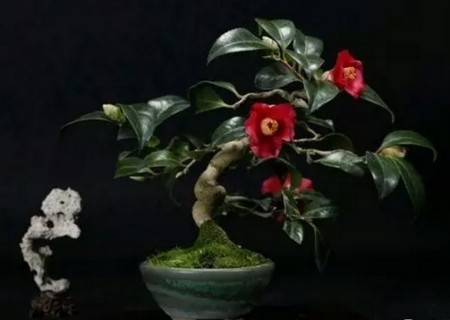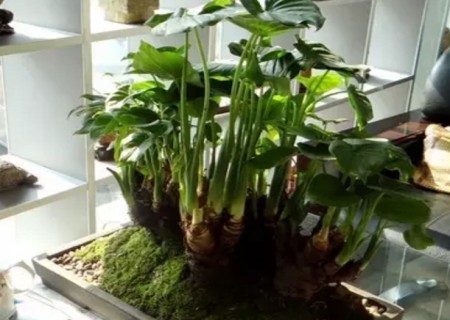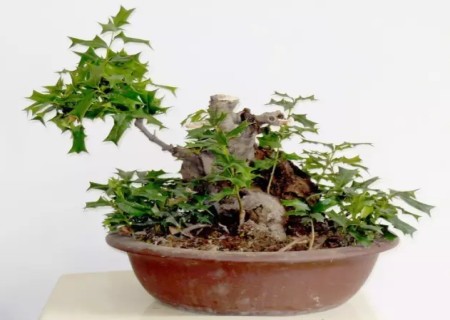How to make tea plum bonsai
Camellia is an evergreen shrub of the family Theaceae, which is called Camellia because its flower pattern has the characteristics of both camellias and plum blossoms. In the Ming Dynasty, Gao Lian wrote a song "Plum Blossom Ling Tea Plum": "Flower is, and Meihun", a few strokes, writing out the charm of tea plum, both like camellias and plum blossoms.
However, we often confuse Camellia with Camellia. Camellia also belongs to the Camellia family. Although from a botanical point of view, there are many differences between the two, such as what flowering aroma, fruit shape, and so on, but when you really see Camellia and Camellia, the storage makes you foggy and watery, but I only care about one move, that is, the form of both falling flowers, Camellia is scattered one by one; Camellia is withered as a whole.

Camellia oleifera, a member of the family Theaceae, gets its name because the flower pattern has the characteristics of both camellias and plum blossoms. Camellia oleifera is a famous flower with exquisite figure, elegant leaf shape and colorful flowers. Although Camellia oleifera is a shrub or small tree, its beautiful appearance attracts many flower friends and chooses to use tea plum to make bonsai.
1. Material selection
The tea plum with low plant, slow growth, small leaf shape and soft branches is more suitable for processing, such as expanding the low winter tea plum.
Ordinary tea plum varieties that are more upright can also try to make towering bonsai, but it is best not to use varieties with tall plants, rapid growth and large flowers and leaves.
2. Material sources
It is best to use 2-3-year-old cuttings or seedlings, because the branches of the seedlings are easy to process and shape, and can be cultivated into a variety of trees by continuous shaping, pruning, hanging and winding in the process of cultivation.
Can also dig dry Qiu wild Camellia, Camellia oleifera and other old plant branches through truncated grafting or the use of old plants to sprout new branches, after continuous modeling, the production of old tea plum pile pots.
3. Modeling
It is usually based on the natural posture of tea plum plant or artistically processed into straight dry type, oblique dry type, double dry type, and can also be cultivated into curved dry type, cliff type, semi-cliff type and so on.
4. Late maintenance
1) generally change the basin once every two to three years, in addition to choosing a good color, size, style of the basin and the plant to match, the basin had better be a little smaller, do not choose a large one, about 1/2 of the crown.
2) properly cut off the damaged roots and part of the old roots to help the shallow roots develop better, and also contribute to the dwarfing of the plants. when planting, the stem base of the plant needs to be slightly higher, beyond the edge of the basin, and the exposed plants should avoid wind blowing and sun exposure.
3) under the condition of not affecting the growth and development, fertilizing as little as possible, in order to keep the tree posture balanced and natural, it is not suitable to cut off the top casually, it is possible to prune slightly in the growing season, and the coring method is used to remove the growth buds of unwanted or too long branches. More intensive pruning and shaping should be carried out before germination. In addition to long branches, if there are over-long or over-proportional branches, the longer part of the tip can be cut off, or it can be shortened by twisting the wire from the bottom to the top. Do not store it indoors for too long, which will affect the growth and development of tea plum.
Camellia is more tough than camellias and more simple than plum blossoms, filling in the gap that there are no flowers to enjoy in winter. Walking along the forest path in the sea of tea and plum blossoms, you will be attracted by the beautiful flowers all over the mountain, and you will be moved by the petals all over the ground! "falling red is not a heartless thing, but it turns into spring mud to protect the flowers!" It turns out that withering can also be so beautiful! Such warmth!
Time: 2019-05-26 Click:
- Prev

The production method of Dishui Guanyin bonsai
Dishui Guanyin, also known as Taro, Guanyinlian, Amorphophallus, etc., is a large evergreen herb of the Araceae, originally from the virgin forests of Southeast Asia and Australia, as well as in South China and Orchid Island. It needs to spend the winter indoors in northern China and can grow in open fields in the south. Corms and leaves can be used medicinally but are highly toxic.
- Next

The method of making star anise bonsai
Star anise thorn, also known as wolfbone, bird does not sleep, belongs to holly family, single leaf alternate, hard leathery, the edge has needle teeth, evergreen all seasons. Sexual preference for light, but also slightly resistant to shade, not resistant to severe cold, slow growth, well-developed root system, strong germination, resistance to pruning, unisexual dioecious, drupe spherical, bright red in autumn and winter
Related
- Fuxing push coffee new agricultural production and marketing class: lack of small-scale processing plants
- Jujube rice field leisure farm deep ploughing Yilan for five years to create a space for organic food and play
- Nongyu Farm-A trial of organic papaya for brave women with advanced technology
- Four points for attention in the prevention and control of diseases and insect pests of edible fungi
- How to add nutrient solution to Edible Fungi
- Is there any good way to control edible fungus mites?
- Open Inoculation Technology of Edible Fungi
- Is there any clever way to use fertilizer for edible fungus in winter?
- What agents are used to kill the pathogens of edible fungi in the mushroom shed?
- Rapid drying of Edible Fungi

